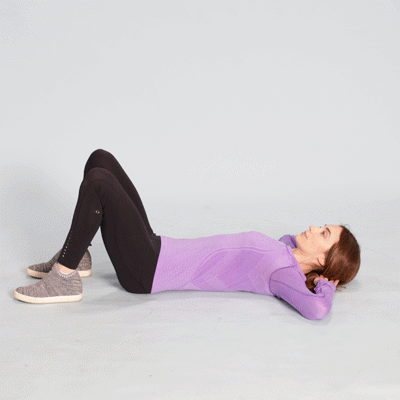Exercise — especially core exercise — is key to maintaining the overall posture and balance needed to perform most daily activities.
While it’s easy to think of your core as one muscle, it’s a group of muscles that make up your abdomen. So, a great core exercise is one that can work the whole group.
Enter the double crunch.
The double crunch combines a crunch with a reverse crunch. By melding the two movements into one, you target multiple abdominal muscles, which helps you yield the benefits of efficiency and effectiveness.
Let’s break it down.

- Lie on your back with your knees bent and feet on the floor, roughly hip-width apart. Place your fingertips behind either side of your head. This is your starting position.
- Engage your abs while lifting your head, shoulders, and upper back.
- Keep your hands on your head while pointing your elbows forward.
- Bring your knees toward your elbows.
- Squeeze your abs at the top of the movement for a second, and then return to the starting position.
Changing it up
As with most exercises, there are ways to adjust the movements to fit your needs.
To keep some of the stress off your lower back: Lift your feet slightly off the floor during a rep, rather than bringing in your knees to meet your elbows.
To raise the level of difficulty: Don’t let your feet touch the ground for the entirety of your set.
The double crunch is obviously going to work your abdominal muscles, but they can also target the muscles in your hips and legs too.
Rather than focusing on your main core area, double crunches will engage muscles in your upper body (keeping your shoulders up and your arms out) and your lower body (elevating your legs off the floor).
Here are some other areas that are targeted with this movement:
- rectus abdominis
- hip flexors
- obliques
When performing a double crunch, keep your back as flush to the ground as you can, using just your abdominal muscles to lift your head and shoulders off the ground.
If you have pain in your neck or back, movements that require you to be on your back might not the best bet for you. You might be better off using a machine or bench for more support. Either way, talk with your doctor or an athletic trainer before proceeding.
If you’re pregnant or recently delivered a baby, check with your doctor before you engage in any core exercises or movements.
Some people choose to do core exercises for aesthetic purposes. #sixpack
While regularly performing core exercises does not guarantee you’ll look a specific way — that’s mostly up to your genetics and your diet — exercising your core still comes with tons of benefits.
It can reduce or prevent lower back pain
Pain in the lower back is something that affects about 31 million Americans at any given time.
Sometimes working out other parts of our bodies can cause lower back pain. If that’s the case, it may be that you have inactive or weak abdominal muscles. Dedicating time to strengthening them can help your body in and out of the gym.
It can increase balance and improve posture
Our core muscles are essential to our day-to-day activities, no matter how strenuous. You don’t have to be an athlete to need good core strength.
If you seem to constantly lose your balance or your body is aching after hours of sitting at your desk, a stronger core can help.
If you’re looking for a simple, efficient, and effective core exercise to add to your arsenal, double crunches are a strong option.
A move that requires no equipment to work all of your abdominal muscles while also engaging your lower body? Sign us up!

